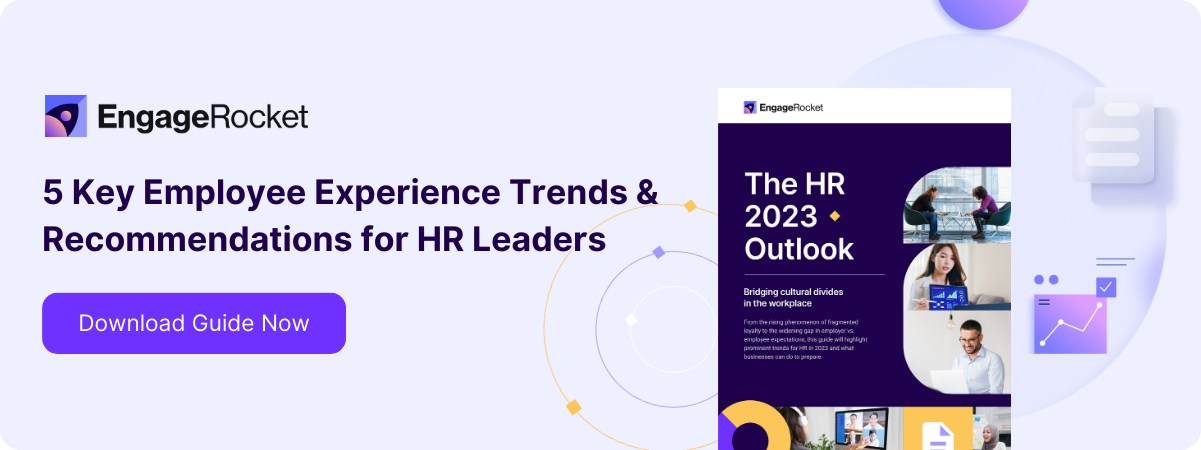My opinion on what's happening with workplaces around the world and why the risk of us being more fragmented is real.
Recently, EngageRocket published our annual HR 2023 Outlook titled: Bridging cultural divides in the workplace, and I think the timing couldn't be more relevant.
In this article, I want to talk about what exactly is happening at workplaces around the globe with the changes that have been happening in the past couple of years.
More importantly, I want to talk about how HR and leaders can step up their game to bridge this cultural divide.
We're moving from a fragmented culture to fragmented loyalty
The concept of cultural fragmentation in companies has been extensively studied and is often seen in distributed organizations.
Employees of fragmented organizations display a low consciousness of organizational membership. They often believe that they work for themselves or they identify with certain groups — usually similar, like-minded people in the organization.
However, now we're seeing its manifestation becoming stronger. Not only fragmented culture, we're moving into the space of fragmented loyalty.
As employees work either remotely or in a hybrid manner, loyalty is becoming stronger within micro-communities and employee groups that are not always connected to the larger workplace.
This is how our Lead People Scientist portrays fragmented loyalty:
“To paint a picture of fragmentation, we can look at the case of organizations that employ essential and non-essential workers. These two groups have very different working arrangements, and the pandemic further exacerbates the contrast. Coming out of the pandemic, organizations need to carefully adjust their engagement plans to cater for the different cohorts.”
Dr Yvonne Tan
Lead People Scientist at EngageRocket
But why are we moving towards fragmented loyalty?
As Yvonne mentioned above, the pandemic highlights the contrast between different employee groups in an organization.
Many essential workers didn't get to 'enjoy the perks' of working from home as opposed to their counterparts (although we later learned that working from home leads to cases of burnout as well). This results in them feeling more understood and connected with fellow essential workers who are in similar situations as them.
Fragmentation is not only limited to employees with different working arrangements. It can also happen with hybrid or remote working teams, especially those that have little interaction with others from different departments.
Our own analysis of 20,000+ employees also confirms this finding.
89% of people feel supported within their own team, yet about 40% of employees are dissatisfied with cross-team collaboration, indicating a breakdown of loyalty and trust beyond one’s immediate peer group.
This is a concerning number if we think about it in the context of fragmentation.
It shows that people are engaging only to a specific cohort - or group of people that they like and interact with frequently. This can be their own teams or friendship groups within the organization.
If someone within the group leaves, it is likely that their peers would get negatively impacted as well - leading to reduced engagement or even followed by more resignations.
I suspect that as remote and hybrid work become even more commonplace in the coming year, we could see an increase in the number of dissatisfaction towards cross-team collaborations.
The fact that 40% of workers are looking to quit their jobs also does not help this case.
People quitting means that they would be looking for a new place to work. If the place they work at has fragmented culture - or worse, fragmented loyalty - what does it mean for new hires that join an organization?
What HR and leaders can do to curb the fragmentation
That being said, there are things that HR and leaders can do to bridge this divide.
It starts by being proactive about enabling connections between employees. We can start by working on two things:
Leverage team and community building to drive organization-wide connection
If employees find it difficult or feel unhappy about collaborations between teams, it can mean a lot of things.
Perhaps there isn't enough opportunity for them to be connected with people from other teams. Or perhaps rigid workflows and bureaucracy makes it hard for them to establish meaningful connections.
Creating a unified sense of purpose across teams is important so they're motivated to work towards a joint vision.
Simple action points can include inter-departmental happy hours, combined teams brainstorming sessions, or cross-team collaboration projects.
When people know exactly how to reach others and there is a solid reason for them to do so, collaboration should happen more naturally.
From there onwards, we can look into removing barriers to effective collaboration and turning this into long-lasting connections - such as the use of communication apps, turning fruitful projects into long-term plans, and so on
This also gives employees the chance to socialize more comfortably with others, creating larger communities and mitigating the risk of fragmentation.
Empower managers to be the connecting bridge between team members and the organization
I'm not exaggerating when I say that managers hold the key to bridging divides.
They know their team members well (or should be) at the individual level and hence, they should know what would drive them to be more connected with others.
Managers should ideally hold both the autonomy and accountability to make cross-team collaborations work.
That being said, it does not mean that leaders simply give a mandate to managers without providing guidance.Not all managers are the same and some need support more than others.
Ideally, each manager is equipped with information about their team members' motivations, aspirations, and state of well-being.
In cases where employees are hesitant to open up because they fear repercussions, platforms that allow for confidential feedback collection like EngageRocket's BELONG is created especially for this.
Once managers know where each of their team members stand, they would better understand the pain points of their team members when it comes to connecting with others.
Platforms like EngageRocket's ACT give managers action suggestions so they would be better equipped to know what to do to engage with their team better, and drive better collaborations as a result.
💡 Read the full highlights or trends and recommendations for the year ahead in the HR 2023 Outlook below:
About the Author

CT Leong is the founder of EngageRocket. Before becoming an entrepreneur, he was a Regional Director of Gallup - one of the world's top HR advisories. He graduated with a degree in Economics at the University of Cambridge, and has an MA in Political Science from Columbia University.




 .
. 